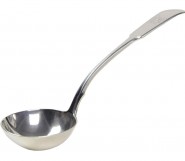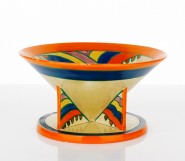Lot #12 - A Boomerang made and used by the King of Murrumbidgee
-
Auction House:Mossgreen
-
Sale Name:Australian Indigenous & Oceanic Art
-
Sale Date:22 Jul 2014 ~ 6.30pm (Part 1 - Lots 1 - 198)
23 Jul 2014 ~ 2.30pm (Part 2 - Lots 199 - 331) -
Lot #:12
-
Lot Description:A Boomerang made and used by the King of Murrumbidgee
Murrumbidgee, New South Wales (mid nineteenth century); carved hardwood and sterling silver
88 cm long -
Provenance:Private Collection, United Kingdom
-
Notes:A fighting boomerang that carries a sterling silver plaque identifying it as having been Ômade and used by the King of Murrumbidgee.Õ Fighting boomerangs are non-returning and were thrown in the air or along the ground to cartwheel towards an opponent. Those from the Murrumbidgee or southern New South Wales region tend to be undecorated and large, up to about 90 cm in length (Jones, P., Boomerang: Behind an Australian icon, Wakefield Press, Adelaide, 1996, p. 98). The literature reveals few clues as to the identity of the ÔKing of MurrumbidgeeÕ although the evidence is inconclusive. In Aborigines of the Canberra Region, L.L. Gillespie, Canberra, 1984, Lyall Gillespie makes reference a young Aboriginal man called Wellington Ôwho was said to be the king of the Murrumbidgee blacks and frequented the Yarralumla areaÕ (Gillespie 1984:21). Yarralumla, now an inner suburb of Canberra, was in the 1840s the home of (Sir) Terence Aubrey Murray (1810-1873), who was to become a member of the Legislative Assembly of New South Wales. In 1844, George Augustus Robinson (1791-1866), the Chief Protector of Aborigines in New South Wales, including the Port Phillip area (Victoria), visited Yarralumla on his journey to south-east Australia. Robinson made a list of forty-eight Aboriginal people he met at or near Yarralumla: a journal entry of 12 September 1844 reads ÔSaw a number of Limestone Blacks at Mr MurrayÕs, Mr Murray invited me to stay, took names:Õ (Clarke, I.D. [ed], The Journals of George Augustus Robinson, Chief Protector, Port Phillip Aboriginal Protectorate, Volume Four: 1 January 1844 - 24 October 1845, Heritage Matters, Melbourne, 1998, pp. 203-4). The name Wellington (Moridjergang) appears on the list and is referred to by Robinson as his ÔinterpreterÕ who ÔcommunicatedÕ (Robinson in Clark 1998:270) to him a vocabulary of local Aboriginal words. Moridjergang was sixteen years of age at the time, and not a member of the Limestone Plains people (Gillespie 1984:31, 59). In later articles, Moridjergang has been described as being a good stockman (W Davis Wright, Canberra, John Andrew and Co., Sydney, 1923) and as Ôa king, very tall [who] wore a breastplateÕ (K. McP., ÔReminiscences of Old CanberraÕ, in the Sydney Morning Herald of 14 January 1922, p. 16). Compare this boomerang to a similar one collected by the naturalist Charles Daley (1859-1947) from south-central New South Wales in the 1890s, now in the collection of the South Australian Museum, which Philip Jones terms Ôan intermediate type between the heavy boomerangs of the Eyre Basin and the lighter, more angular boomerangs of south-eastern AustraliaÕ (Jones 1996:100). Wally Caruana
-
Estimate:A$8,000 - 12,000
-
Realised Price:
-
Category:Tribal
This Sale has been held and this item is no longer available. Details are provided for information purposes only.













